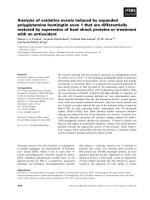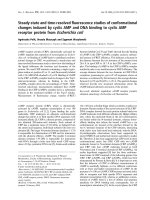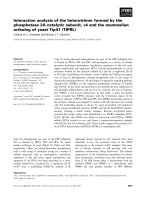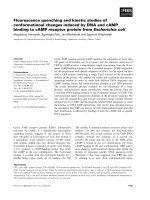Uncertainty analysis of ground movement induced by deep excavation
Bạn đang xem bản rút gọn của tài liệu. Xem và tải ngay bản đầy đủ của tài liệu tại đây (2.12 MB, 184 trang )
UNCERTAINTY ANALYSIS OF GROUND MOVEMENT
INDUCED BY DEEP EXCAVATION
KORAKOD NUSIT
NATIONAL UNIVERSITY OF SINGAPORE
2011
UNCERTAINTY ANALYSIS OF GROUND MOVEMENT
INDUCED BY DEEP EXCAVATION
KORAKOD NUSIT
(M.Eng. AIT, Thailand)
A THESIS SUBMITTED
FOR THE DEGREE OF MASTER OF ENGINEERING
DEPARTMENT OF CIVIL ENGINEERING
NATIONAL UNIVERSITY OF SINGAPORE
2011
Dedicated to My beloved Baby
ACKNOWLEDGEMENTS
The author wishes to express his gratitude and deepest appreciation to Professor
Phoon Kok Kwang, for his generous guidance, valuable support, and practical
intuition throughout the period of his thesis work.
Profound gratitude is to Professor Leung Chun Fai, Associate Professor Tan
Siew Ann and Professor Somsak Swaddiwudhipong for providing guidance, supports,
comments, and suggestions in conducting this thesis as well as lecture study.
Special thanks are contributed to Dr. Cheng Yonggang, Dr. Krishna Chuahary,
Dr. Anastasia Santoso, Mr. Wu Jun, and all other NUS colleagues who provided the
supportive ideas, suggestions and good will in responding to many questions
regarding to this thesis.
Finally, the author would like to express his deepest love and gratitude to his
beloved family for their support, inspiration, and encourage for the author to
overcome his tasks and all obstacles.
ii
TABLE OF CONTENTS
Page
ACKNOWLEDGEMENTS
ii
TABLE OF CONTENTS
iii
SUMMARY
vi
LIST OF TABLES
viii
LIST OF FIGURES
x
ABBREVIATIONS
xvi
NOMENCLATURE
xvii
CHAPTER 1 INTRODUCTION
1
1.1
Introduction
1
1.2
Previous studies on reliability-based design in deep excavation
2
1.3
Prediction of maximum wall deflection and its uncertainties
5
1.4
Objectives and scopes of the study
6
1.5
Organization
7
CHAPTER 2 LITERATURE REVIEW
9
2.1
9
Building damage assessment due to excavation-induced ground
movement
2.2
Excavation-induced ground movement
12
2.2.1 Ground movement prediction using empirical and semi-
12
empirical method
2.3
2.2.2 Ground movement prediction using numerical method
15
2.2.3 Ground movement prediction using analytical method
17
2.2.4 Factors affecting ground movement mechanisms
18
Reliability analysis of deep excavations
19
2.3.1 Current methods on serviceability reliability-based design in
19
excavation
2.4
2.3.2 Model uncertainty of the ground movement prediction methods
22
Summary
23
iii
Page
CHAPTER 3 PREDICTION OF MAXIMUM WALL DEFLECTION
35
3.1
Introduction
35
3.2
Database of the excavation-induced ground movement
37
3.2.1 Worldwide database
37
3.2.2 Local database
39
Selected case histories
41
3.3.1 Subdivision of case histories
41
3.3.2 Excavation-induced ground movement of the selected case
44
3.3
histories
3.4
MSD method with hyperbolic soil model
44
3.5
Material models and material properties in the FE analysis
48
3.6
Excavation geometries and construction sequences
49
3.7
Verification of FE model with field measurement
50
3.8
Parametric study
51
3.8.1 Effect of the excavation geometries
51
3.8.2 Effect of the soil properties and wall stiffness
53
Limitation of MSD method and its development
56
3.9
3.10 Comparison of the predicted ground movement
57
3.11 Estimation of the ground movement prediction model uncertainties
58
3.11.1 Database
59
3.11.2 Development of the model factors
60
3.11.2.1 Correction on (δhm)MSD and (δhm/H)MSD using the ratio
61
method
3.11.2.2 Correction on (δhm)MSD and (δhm/H)MSD using the
62
linear function method
3.11.3 Selection of the model factor approach
62
CHAPTER 4 ESTIMATION OF MODEL UNCERTAINTY
93
4.1
Background
93
4.2
Bias factors calculation
98
4.2.1 Bias factor due to the input parameters (BFs)
98
4.2.2 Bias factor due to the prediction model error (BFm)
100
iv
Page
4.2.3 Bias factor due to the effect of factors not normally accounted
103
for in BFm (BFo)
4.2.3.1 Bias factor due to the effect of wall stiffness (BFE)
104
4.2.3.2 Bias factor due to the effect of excavation width (BFB)
105
4.2.3.3 Bias factor due to the effect of hard stratum
106
underneath the excavation base (BFT)
4.2.4 Correlation
107
Application of the computed bias factors
108
4.3.1 Application example of the proposed probabilistic model
109
4.4
Validation of the probabilistic model
110
4.5
Predicting the field measurement
113
4.3
CHAPTER 5 CONCLUSIONS
134
5.1
Conclusions
134
5.2
Recommendations for the future research
138
REFERENCES
139
APPENDIX A
v
SUMMARY
Ground movements during deep excavation construction need to be carefully controlled,
particularly in built-up areas. Excessive ground movements can affect serviceability, and
in the worst case, cause failure of adjacent buildings. Hence, ground movements are
routinely predicted in the design process and are monitored during excavation. Recently,
the Reliability-Based Design (RBD) of deep excavation has been developed as an
alternative design approach, which is perhaps the most rational and consistent approach.
Presently, empirical equations, semi-empirical equations or closed-form analytical
equations are normally required in the serviceability RBD approach for estimating the
excavation-induced ground movements. However, its associated uncertainties are
necessary in the RBD analysis and need to be quantified.
In this study, an updated database on excavation-induced ground movement from
previous studies was investigated and summarized. Prior to the model uncertainty
quantification, the most accurate method of ground movement prediction is required to be
identified. The accuracy of various prediction methods were examined using measured
data. The comparison results show that, the Mobilized Strength Design method (MSD)
seems to provide the most reasonable fit to the measured deflections. However, the
accuracy of MSD is affected by the input parameters which were not included in the
prediction method. These input parameters are excavation width (B), depth of hard
stratum underneath the excavation base (T) and retaining wall stiffness (EwI). The effects
vi
of each design parameters on the accuracy of MSD method were further investigated
during the parametric study. Therefore, the range of input parameters that MSD method
is believed to provide the most reasonable fit to the measured deflections can be obtained.
The lumped model errors calibrated using real field data were formerly evaluated.
The estimation of lumped model errors using field data implies that, correction on the
maximum lateral wall deflection (δhm) using linear function method provides the most
reasonable approach. Using the values of predicted maximum lateral wall movement
[(δhm)MSD] as the predictor provides the highest values of coefficient of determination
(R2). However, using the measured data alone may not be enough, since uncertainties
arising from different input parameters are difficult to define from limited number of
measured data. Therefore, the model errors or bias factors arising from different input
parameters were quantified using artificial data generated from FE analysis. The other
important bias factors could be easily added to the proposed probabilistic model, if they
are found to be significant. Model validation using both field and FE data shows that, the
proposed probabilistic model is useful. Finally, a reasonable framework for quantifying
the model errors and uncertainties of the selected ground movement prediction method
can be established from this research.
vii
LIST OF TABLES
Page
Table 2.1
Conclusion of the factors related to excavation-induced ground
surface settlement prediction
33
Table 2.2
Previous studies on maximum lateral wall deflection (δhm),
maximum ground surface settlement (δvm) and maximum
lateral surface movement (δlm) due to excavation
34
Table 3.1
Information of the selected case histories Group I
83
Table 3.2
Information of the selected case histories Group II
85
Table 3.3
Undrained stiffness of cohesive soil (Eu)
90
Table 3.4
Material model and material properties used in the parametric
study
90
Table 3.5
Case histories used to quantify the model uncertainty of the
maximum lateral wall deflection predicted using the MSD
method
91
Table 3.6
Regression analysis of correction factor using ratio method
91
Table 3.7
Regression analysis of correction factor using linear function
method
91
Table 3.8
Comparison of the regression analysis results
92
Table 4.1
Means and Coefficient of Variation (COV) of BFm values
subjected to different normalized undrained shear strength
values of soil (cu/σ’v)
128
Table 4.2
Pearson’s correlation (ρ) and p-values of each bias factors
129
Table 4.3
Statistical parameters of BFm, BFE, BFB, and BFT.
130
Table 4.4
Input parameters of the Taipei National Enterprise Center
(TNEC) case
131
Table 4.5
Bias factors application and uncertainties of (δhm)MSD compared
131
viii
Page
with (δhm)FEM and (δhm)FIELD
Table 4.6
Validation of the purposed probabilistic model using 19 case
histories
132
ix
LIST OF FIGURES
Page
Figure 2.1
Definition of the angular distortion (β) and lateral strain (εl)
(Schuster 2008)
25
Figure 2.2
Characteristics of excavation-induced building damage (Son
and Cording 2005)
25
Figure 2.3
Inflection point (D) between “Sagging” and “Hogging” of
the ground surface settlement profile (Finno et al. 2005)
26
Figure 2.4
Summary of the soil settlements behind in-situ walls (Peck
1969)
26
Figure 2.5
Dimensionless diagrams proposed by Clough & O’Rourke
(1990) (Reprinted by Kung et al. 2007)
27
Figure 2.6
Data set categorized by Long (2001) based on the different
in soil condition, factor of safety against basal heave, and
mode of wall movement
28
Figure 2.7
Dimensionless diagrams for the surface settlement
prediction in soft to medium clay from previous studies
28
Figure 2.8
Excavation geometry and material properties used in the
analysis of Hashash & Whittle (1996)
29
Figure 2.9
Excavation sequence in the study by Hashash & Whittle
(1996)
29
Figure 2.10
Subsurface settlement prediction from wall deflection values
proposed by Bowles (1988) (Modified by Aye et al. 2006)
30
Figure 2.11
Deformation zone of the excavation supported by cantilever
wall (Osman & Bolton 2004)
30
Figure 2.12
Factors affect ground movement mechanism (Goh 1994)
31
Figure 2.13
Procedure for evaluating the potential for excavationinduced building (Schuster 2008)
32
x
Page
Figure 3.1
Maximum lateral wall deflections (δhm) of the case histories
Group I and II
64
Figure 3.2
Maximum ground settlement (δvm) of the case histories
Group I and II
64
Figure 3.3
The normalized maximum lateral wall deflection
(δhm/H)FIELD plotted against normalized maximum ground
settlement (δvm/H)FIELD of the selected case histories
65
Figure 3.4
Plastic deformation mechanisms for braced excavation in
clay proposed by Osman & Bolton (2006)
65
Figure 3.5
The average undrained shear strength of soil at mid-length
of wall (cu,avg)
66
Figure 3.6
Shape and size of the plastic zone controlled by excavation
width (B) and the depth to the hard layer underneath the
excavation base (T) – (Modified from Bolton 1993)
66
Figure 3.7
Finite element model for the parametric study
67
Figure 3.8
Comparison between normalized maximum lateral wall
deflections predicted from FE analysis (δhm/H)FEM and field
measurement (δhm/H)FIELD
67
Figure 3.9
Comparison between normalized maximum ground
settlement at the final stage of excavation from FE analysis
(δvm/Hf)FEM and field measurement (δvm/Hf)FIELD
68
Figure 3.10
The variation of Erh =
(δ hm / H ) MSD
plotted against H/L of the
(δ hm / H ) FEM
69
different wall stiffness and strut spacing (h)
Figure 3.11
Comparison of the predicted maximum lateral wall
deflection (δhm) between this study and numerical analysis
by Hashash & Whittle (1996) for the diaphragm wall with L
= 60 m, K0 = 1 and cu/σ’v = 0.21
70
Figure 3.12
Effect of excavation width (B) to the values of Erh
70
Figure 3.13
Effect of hard stratum to the predicted wall movement
values (L = 25.0 m., h = 2.0 m.)
71
xi
Page
Figure 3.14
(a) Effect of the wall stiffness (EwI), and (b) System stiffness
(EwI/γwh4) to the values of Erh
72
Figure 3.15
Movement profiles of diaphragm wall and sheet pile wall
from FE analysis compared with MSD method when the
excavation depth (H) equal to 2, 10 and 14 m. (L = 25.0 m.,
h = 2.0 m.)
73
Figure 3.16
(a) Effect of the undrained shear strength of soil (cu) to the
values of Erh, and (b) with the different values of H/L
74
Figure 3.17
Effect of the coefficient of earth pressure at rest (K0) to the
values of Erh
75
Figure 3.18
(a) Comparison between MSD MIT-E3 and FE MIT-E3 for
lateral displacement profile by Osman & Bolton (2006) (b)
Predicted lateral displacement profile using MSD with
Hardening soil model (MSD HS)
76
Figure 3.19
Normalized maximum lateral wall deflections (δhm/H)i
predicted using MSD method, KJHH model and method
proposed by Clough & O’Rourke (1990)* compared with
field measurement (* Computed by Hsieh & Ou 1998) of
the case histories Group I
77
Figure 3.20
Normalized maximum lateral wall deflections (δhm/H)i
predicted using MSD method and KJHH model compared
with field measurement of the case histories Group II
77
Figure 3.21
Comparison between the predicted normalized maximum
lateral wall deflection (δhm/H)MSD and field measurements
(δhm/H)FIELD of the case histories Group I
78
Figure 3.22
Measured normalized maximum lateral wall deflection plots
against system stiffness and factor of safety against basal
heave proposed by Clough & O’Rourke (1990)
78
Figure 3.23
Relationship between CF = (δhm)FIELD/(δhm)MSD and the
excavation depth (m.)
79
Figure 3.24
Regression plot between CF (Site/MSD) and excavation
depth (m.)
79
Figure 3.25
Regression plot between (δhm)FIELD (Site) and (δhm)MSD
80
xii
Page
(MSD)
Figure 3.26
Regression plot between (δhm/H)FIELD (NormSite) and
(δhm/H)MSD (NormMSD)
80
Figure 3.27
Model error (ε) plots against (δhm)MSD predicted from
regression equation [Eq. (3.12a)]
81
Figure 3.28
Model error (ε) plots against (δhm)MSD predicted from
regression equation [Eq. (3.12a)]
81
Figure 3.29
Frequency distribution of model error (ε)
82
Figure 3.30
The probability plot of model error (ε)
82
Figure 4.1
Changes of BF m with the variation of (a) Excavation depth
(H), (b) Wall length (L), (c) Strut spacing (h) and (d)
Normalized undrained shear strength (cu/σ’v)
115
Figure 4.2
Distributions of BFm for the case of (a) cu/σ’v = 0.20, (b)
cu/σ’v = 0.25, (c) cu/σ’v = 0.30, (d) cu/σ’v = 0.33, (e) cu/σ’v =
0.38, (f) cu/σ’v = 0.40
116
Figure 4.3
Probability plot of BFm for the case of (a) cu/σ’v = 0.20, (b)
cu/σ’v = 0.25, (c) cu/σ’v = 0.30, (d) cu/σ’v = 0.33, (e) cu/σ’v =
0.38, (f) cu/σ’v = 0.40
116
Figure 4.4
Statistical parameters and variation of BF E based on
different wall stiffness (EwI) and cu/σ’v
117
Figure 4.5
Distributions of BFE for the case of EwI = 24.2 MNm2/m and
(a) cu/σ’v = 0.20, (b) cu/σ’v = 0.25, (c) cu/σ’v = 0.30, (d)
cu/σ’v = 0.33, (e) cu/σ’v = 0.38, (f) cu/σ’v = 0.40
117
Figure 4.6
Distributions of BFE for the case of EwI = 80.5 MNm2/m and
(a) cu/σ’v = 0.20, (b) cu/σ’v = 0.25, (c) cu/σ’v = 0.30, (d)
cu/σ’v = 0.33, (e) cu/σ’v = 0.38, (f) cu/σ’v = 0.40
118
Figure 4.7
Probability plot of BFE for the case of EwI = 24.2 MNm2/m
and (a) cu/σ’v = 0.20, (b) cu/σ’v = 0.25, (c) cu/σ’v = 0.30, (d)
cu/σ’v = 0.33, (e) cu/σ’v = 0.38, (f) cu/σ’v = 0.40
118
xiii
Page
Figure 4.8
Probability plot of BFE for the case of EwI = 80.5 MNm2/m
and (a) cu/σ’v = 0.20, (b) cu/σ’v = 0.25, (c) cu/σ’v = 0.30, (d)
cu/σ’v = 0.33, (e) cu/σ’v = 0.38, (f) cu/σ’v = 0.40
119
Figure 4.9
The variation of BF B for the different values of B and cu/σ’v
119
Figure 4.10
The variation of BF B for the different values of B and L
120
Figure 4.11
Statistical parameters and variation of BF B based on
different excavation width (B) and cu/σ’v
120
Figure 4.12
Distributions of BFB for the case of B = 20 m., B = 50 m.
and B = 80 m.
121
Figure 4.13
Probability plot of BFB for the case of B = 20 m., B = 50 m.
and B = 80 m.
121
Figure 4.14
Statistical parameters and variation of BF T based on
different T/B
122
Figure 4.15
Distribution of BFT for the case of T/B = 0.14, T/B = 0.16,
T/B = 0.18 and T/B = 0.20
122
Figure 4.16
Distribution of BFT for the case of T/B = 0.22, T/B = 0.24,
T/B = 0.26, T/B = 0.28 and T/B = 0.30
123
Figure 4.17
Distribution of BFT for the case of T/B = 0.32, T/B = 0.34,
T/B = 0.36, T/B = 0.38 and T/B = 0.40
123
Figure 4.18
Probability plot of BFT for the case of B/T = 0.14 to 0.40
124
Figure 4.19
Excavation levels of TNEC case
124
Figure 4.20
Comparison between (δ hm )computed , (δhm)FEM and (δhm)FIELD of
125
the TNEC case
Figure 4.21
Histogram of BFm calculated from field data compared with
BFm purposed in this study
125
Figure 4.22
Comparison between (δhm)i and (δhm)FIELD
126
Figure 4.23
Comparison between (δ hm )computed and (δhm)FEM
126
xiv
Page
Figure 4.24
Comparison between (δ hm )computed and (δhm)FIELD
127
Figure 4.25
Comparison between Ωexpected and Ωcomputed
127
xv
ABBREVIATIONS
LSD
Limit State Design
LRFD
Load and Resistance Factor Design
ULS
Ultimate Limit State
SLS
Serviceability Limit State
RBD
Reliability-Based Design
MSD
Mobilized Strength Design
FE
Finite Element
FS
Factor of Safety
FEM
Finite Element Method
KJHH
Kung-Juang-Hsiao-Hashash
KJSH
Kung-Juang-Schuster-Hashash
FORM
First Order Reliability Method
AIR
Apparent Influence Range
DSS
Direct Simple Shear
HS
Hardening Soil
xvi
NOMENCLATURE
δh
= Lateral wall deflection
δhm
= Maximum lateral wall deflection
δhm,m
= Modified maximum lateral wall deflection which considering the
effect of hard stratum underneath the excavation base
δwm
= Incremental maximum lateral wall deflection
δl
= Lateral ground movement
δlm
= Maximum lateral ground movement
δv
= Ground settlement
δvm
= Maximum ground settlement
δv
= Incremental vertical settlement
Κ
= Deflection reduction factor
(δvm/H)FIELD
= Normalized maximum ground settlement measured from field
(δhm)FIELD
= Maximum lateral wall deflection measured from field
(δhm)FEM
= Maximum lateral wall deflection predicted from FE analysis
(δhm)computed
= Maximum lateral wall deflection generated using FE analysis for
xvii
developing the probabilistic model in Chapter 4
(δhm)MSD
= Maximum lateral wall deflection predicted from MSD method
(δhm)i
= Predicted maximum lateral wall deflection
(δhm)computed,EI
= Maximum lateral wall deflection generated from FE analysis with
different values of wall stiffness from the reference case
(δhm)computed,B
= Maximum lateral wall deflection generated from FE analysis with
different values of excavation width from the reference case
(δhm)computed,T
= Maximum lateral wall deflection generated from FE analysis with
different values of T/B but less than 0.4
(δhm/H)FIELD
= Normalized maximum lateral wall deflection measured from field
(δhm/H)FEM
= Normalized maximum lateral wall deflection predicted from FE
analysis
(δhm/H)MSD
= Normalized maximum lateral wall deflection predicted from MSD
method
(δhm/H)i
= Predicted normalized maximum lateral wall deflection
Erh
= Normalized maximum lateral wall deflection predicted from MSD
method divided by the values predicted from FE analysis
β
= Reliability index
β∗
= Proportional strength mobilized of soil
(The proportional strength mobilized in the original paper was
xviii
represented by β, but replaced by β* in this study in order to avoid
overlapping with the original symbol representing the reliability
index)
β
= Angular distortion
βlim
= Limiting angular distortion
θmax
= Direction of crack formation measured from the vertical plane
εl
= Lateral strain
εp
= Principal strain
εt
= Structure cracking strain
εlg
= Lateral strain of the ground related to the Greenfield condition
δγ
= Incremental engineering shear strain
γmob
= Mobilized shear strain
δγmob
= Incremental mobilized shear strain
D
= Inflection point
R
= Deformation ratio
GS
= Ground slope of settlement trough
GL
= Ground surface level
∆S
= Differential ground settlement
xix
Es
= Stiffness of soil in the region of footing influence
L
= Length of the building portion subjected to the movement
b
= Building wall thickness
G
= Elastic shear modulus of building
H
= Height of the building
H
= Excavation depth
Hf
= Final excavation depth
B
= Excavation width
L
= Length of retaining wall
D
= Embedment length of retaining wall
d
= Horizontal distance to the interested point
T
= Depth to the hard stratum underneath the excavation base
l
= Wavelength
s
= Length of the wall beneath the lowest support
Nb
= Stability number
Ncb
= Critical stability number for the base heave
cb
= Undrained shear strength at the excavation base level
cu
= Undrained shear strength of soil
xx
cmob
= Mobilized undrained shear strength of soil
cu,avg
= Average undrained shear strength of soil
K0
= Coefficient of earth pressure at rest
OCR
= Over consolidation ratio
PI
= Plasticity index
ν’
= Effective poisson ratio
νu
= Undrained poisson ratio
νur
= Unloading poisson ratio
qf
= Deviatoric stress at the failure point
Rf
= Curve-fitting constant
γ
= Saturated unit weight of soil
γt
= Total unit weight of soil
γw
= Unit weight of water
α
= Wall-end fixity condition
Ew
= Young’s modulus of retaining wall
I
= Moment of initial of retaining wall
h
= Vertical strut spacing
Ac
= Area of cantilever component
xxi
Ei
= Initial Young’s modulus of soil
Eu
= Undrained Young’s modulus of soil
Eur
= Unloading Young’s modulus (Elastic) of soil
E50
= Secant Young’s modulus of soil when loading reach 50% strain
σv’
= Effective overburden pressure
P
= Performance function
S
= Load
R
= Resistance
Prob(.)
= Probability of an event
pf
= Probability of failure
pT
= Acceptable probability of failure
-Φ-1(.)
= Inverse standard normal cumulative function
DPI
= Damage potential index
DPIR
= Limiting damage potential index
DPIL
= Applied damage potential index
r
= Probability ratio
PD
= Probability of damage
PND
= Probability of no damage
xxii
CF
= Correction factor
CI
= Confident interval
BF
= Bias factor
SD
= Standard deviation
COV
= Coefficient of variation
R2
= Coefficient of determination
ε
= Random model error
µε
= Mean of error
σε
= Standard deviation of error
ρ
= Pearson’s correlation
Nm
= Model error corresponding to a prediction method
Nf
= Model error associated with load test procedures
Ns
= Model error due to the effect of input soil parameters
No
= Model error arising from the factors which were not normally
accounted in the prediction model
Ni
= Combined correction factor
Ni
= Mean value of the combined correction factor
Ωi
= Coefficient of variation of the combined correction factor
xxiii









